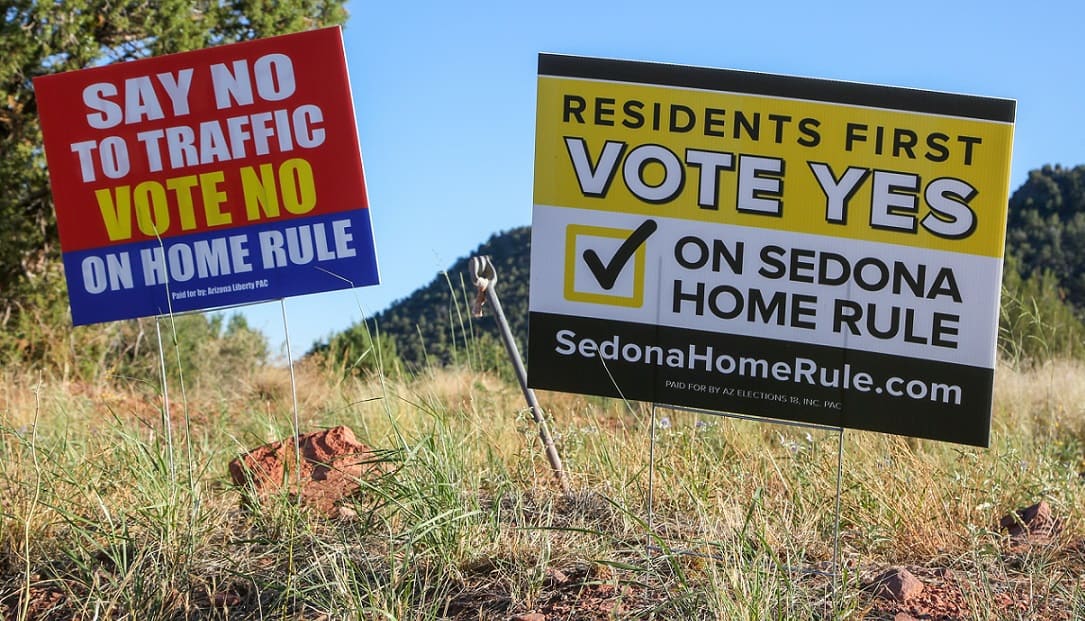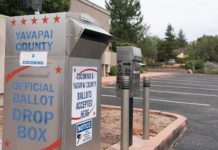With every election cycle comes the inevitable proliferation of campaign signs, dotting the landscape like claim stakes in the Oklahoma Land Run of 1893.
Campaign signs carry more weight when they appear on the lawns of your neighbors, real flesh-and-blood voters, rather than dumped on the open or undeveloped parcels like the hawking of fen-phen diet drugs by unscrupulous conmen in the 1990s.
Despite this, campaigns take to posting signs in Arizona Department of Transportation right of ways or on city, state or county land where they can be placed to get the attention of potential voters as they drive by.
Campaign ads in print, online, radio or television influence voters because they can capture a person’s attention for a period of time. Television and radio ads can give voters an avenue to learn more, such as a website link. Print and online ads can provide specific details about policies and plans and redirect interested views to websites.
Campaign signs along the highway merely shout the candidate’s name or a “yes” or a “no” on a ballot measure with no substance beyond that.
For example, in the Cottonwood area, where voters from the Mingus Union High, Cottonwood-Oak Creek and Clarkdale-Jerome school districts will decide in November whether to consolidate, there are three types of plentiful signs around town. One urges a “yes,” one recommends a “no,” and a third reads — in its entirety — “Consolidation is bad.”
The folks behind this sign purportedly run schools to educate our children and the best adjective they can find is “bad”?
The voter packet about consolidation is 55 pages long, and it’s summed up with “bad”? Regardless of the vote, please someone provide the folks with a children’s thesaurus.
The point being that campaign signs along the side of the road do not sway elections. They merely remind voters that so-and-so is running for office. Occasionally they add a word or two such as “pro-life,” “gun control,” “proven conservative” or “progressive voice,” something that can be digested at 45 mph.
Even among those categories, there are levels and degrees and nuances, so shouting one word at drivers really doesn’t tell them how candidates actually feel about their pet issues. If a candidate’s sign screams “pro-choice” or “pro-life” and abortion is at the bottom of your list of priorities, it doesn’t tell you anything useful about the candidate.
In a primary, these words are meaningless. Three Republicans can post “conservative” on their signs, but who’s “conservative-est?” Someone in the middle of the party? On the fringe? It’s a spectrum. Do voters want a far-right, ideological conservative or a moderate conservative who will work with Democrats to pass legislation?
A candidate could check off all the points on the party platform and sound great in an election, but fringe ideologues on the right or left can’t pass bills, so really what’s the point of electing them?
Sedona and some Verde Valley communities have avoided the clutter of signs when candidates running for office made verbal agreements to not clutter the landscape with signs. In 2014, Sedona City Council candidates codified this tacit agreement with an open letter to the public and then stuck to it.
Four years later, new candidates declined to agree to such a deal and peppered the city with signs. The candidates who had the most signs around the city all lost, perhaps because of karma, perhaps because Sedona is Sedona, or perhaps because candidates with the least to offer voters pour their resources into signs and attack ads rather than telling voters where they stand.
Voters sometimes vote against candidates with mean attack ads. Likewise, candidates also run the risk of turning off fickle voters if their signs are ugly and dirty up the neighborhoods or city streets.
We are just short of a month away from the Tuesday, Nov. 3, general election. If you’re uncertain about candidates, visit their websites. Check your local newspaper — we have candidate profile stories archived on both redrocknews.com and journalaz.com — or look them up on nonpartisan websites like Ballotpedia, the League of Women Voters’ Vote411, PolitiFact, IssueVoter or FactCheck.org.
There are plenty of places to learn more about your future election officials or ballot propositions rather than rubbernecking on the roadway and causing an accident.






















